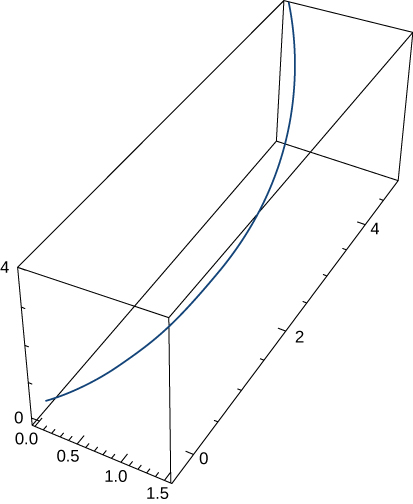12.5E: Exercises for Section 12.5
( \newcommand{\kernel}{\mathrm{null}\,}\)
Finding Components of Acceleration & Kepler's Laws
1) Find the tangential and normal components of acceleration for ⇀r(t)=t2ˆi+2tˆj when t=1.
- Answer:
- a⇀T=√2,a⇀N=√2
In questions 2 - 8, find the tangential and normal components of acceleration.
2) ⇀r(t)=⟨cos(2t),sin(2t),1⟩
3) ⇀r(t)=⟨etcost,etsint,et⟩. The graph is shown here:

- Answer:
- a⇀T=√3et,a⇀N=√2et
4) ⇀r(t)=⟨23(1+t)3/2,23(1−t)3/2,√2t⟩
5) ⇀r(t)=⟨2t,t2,t33⟩
- Answer:
- a⇀T=2t,a⇀N=2
6) ⇀r(t)=t2ˆi+t2ˆj+t3ˆk
7) ⇀r(t)=⟨6t,3t2,2t3⟩
- Answer:
- a⇀T=6t+12t3√1+t2+t4,a⇀N=6√1+4t2+t41+t2+t4
8) ⇀r(t)=3cos(2πt)ˆi+3sin(2πt)ˆj
- Answer:
- a⇀T=0,a⇀N=12π2
9) Find the tangential and normal components of acceleration for ⇀r(t)=acos(ωt)ˆi+bsin(ωt)ˆj at t=0.
- Answer:
- a⇀T=0,a⇀N=aω2
10) Suppose that the position function for an object in three dimensions is given by the equation ⇀r(t)=tcos(t)ˆi+tsin(t)ˆj+3tˆk.
a. Show that the particle moves on a circular cone.
b. Find the angle between the velocity and acceleration vectors when t=1.5.
c. Find the tangential and normal components of acceleration when t=1.5.
- Answer:
- c. a⇀T=0.43m/sec2,a⇀N=2.46m/sec2
11) The force on a particle is given by ⇀f(t)=(cost)ˆi+(sint)ˆj. The particle is located at point (c,0) at t=0. The initial velocity of the particle is given by ⇀v(0)=v0ˆj. Find the path of the particle of mass m. (Recall, ⇀F=m⇀a.)
- Answer:
- ⇀r(t)=(−costm+c+1m)ˆi+(−sintm+(v0+1m)t)ˆj
12) An automobile that weighs 2700 lb makes a turn on a flat road while traveling at 56 ft/sec. If the radius of the turn is 70 ft, what is the required frictional force to keep the car from skidding?
13) Using Kepler’s laws, it can be shown that v0=√2GMr0 is the minimum speed needed when θ=0 so that an object will escape from the pull of a central force resulting from mass M. Use this result to find the minimum speed when θ=0 for a space capsule to escape from the gravitational pull of Earth if the probe is at an altitude of 300 km above Earth’s surface.
- Answer:
- 10.94 km/sec
14) Find the time in years it takes the dwarf planet Pluto to make one orbit about the Sun given that a=39.5 A.U.
Contributors
Gilbert Strang (MIT) and Edwin “Jed” Herman (Harvey Mudd) with many contributing authors. This content by OpenStax is licensed with a CC-BY-SA-NC 4.0 license. Download for free at http://cnx.org.


